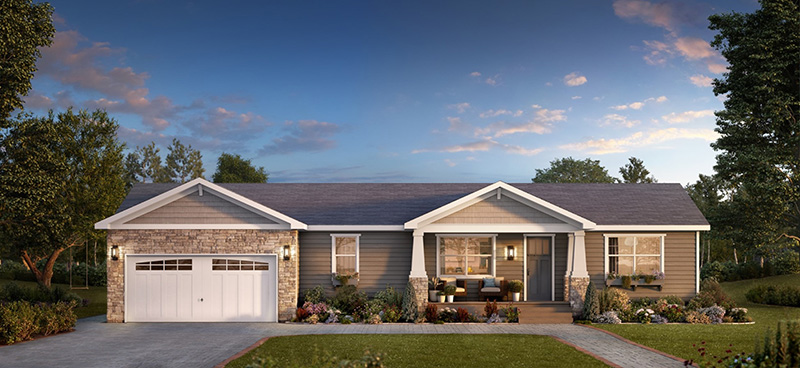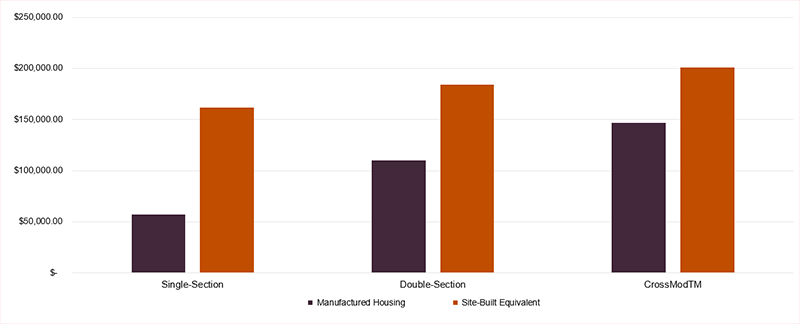Comparing the Costs of Manufactured and Site-Built Housing
Across the US, homeownership is becoming increasingly inaccessible for low- and moderate-income households. While land costs are a driving force in this trend, construction costs carry some of the blame as well. However, “Comparison of the Costs of Manufactured and Site-Built Housing,” a new paper I co-authored with Chris Herbert and James Shen finds that manufactured housing offers a potential solution to rising construction costs, with a significant cost advantage over site-built homes. Given this cost advantage, we suggest that housing advocates and policymakers take steps to promote more widespread adoption of manufactured housing as an affordable alternative to site-built housing for aspiring homebuyers.
Previous studies have attempted to compare the costs of manufactured and site-built homes, but they often overlooked crucial factors such as size, amenities, and the expenses associated with transporting and siting manufactured homes. Our study aims to fill this gap by analyzing three common types of manufactured homes: single-section, double-section, and the recently introduced CrossModTM variant, which strives to emulate the appearance of site-built homes.
Figure 1. CrossModTM Home

Historically, single- and double-section homes have constituted the vast majority of all manufactured housing sold in the US. However, CrossModTM, while currently only comprising a small percentage of total manufactured homes sold annually, represents a notable step forward for the industry. Formally introduced in 2019, the category was developed by the Manufactured Housing Institute (MHI), a national trade organization, to target homebuyers who would not otherwise consider purchasing a manufactured home. CrossModTM’s enhanced appeal is a function of a set of specific design standards intended to make the homes less distinguishable from site-built homes. In addition to expanding consumer interest, through this strategy, the category has the potential to help overcome community opposition to manufactured housing, which is often rooted in negative perceptions of the homes’ aesthetics.
The CrossModTM variant also brings competitive options for financing, thereby addressing another longstanding barrier to more widespread manufactured housing adoption. In the past, chattel or personal property loans, which tend to have higher interest rates and shorter repayment terms than traditional mortgages, have prevailed in the manufactured housing industry. However, under new, CrossModTM-specific financing programs offered by Freddie Mac and Fannie Mae which treat manufactured housing as real property, CrossModTM buyers will be able to obtain mortgages like those available to the buyers of site-built homes. Under the new GSE programs, CrossModTM homes can also be appraised using site-built homes as comparables, furthering their financial appeal.
Our cost estimates for manufactured housing come from a survey conducted by Next Step, an industry nonprofit, in Q2 of 2020. Survey participants, which included builders, retailers, and lenders, were asked to provide cost estimates for various elements of manufactured home production and siting. For site-built homes, we used data from RSMeans, a trusted budgeting and estimating database, to generate estimates for homes similar in size and design to the manufactured homes for which estimates were obtained from the Next Step survey. All estimates come from before the onset of the inflation which followed the COVID-19 pandemic, but the focus of the study is on relative costs, which should be more stable.
Single-section, double-section, and CrossModTM manufactured homes were all found by our study to offer sizeable savings as compared to their site-built counterparts, with manufactured housing construction costs ranging from 35 to 73 percent of site-built equivalents (Figure 2). Although the CrossModTM category demonstrated a smaller cost advantage than single- and double-section manufactured housing, at 27 percent less than comparable site-built, the advantage it offers is still significant.
Figure 2. New Home Construction Costs, Q2 2020
While the cost of land is excluded from this analysis, the paper does acknowledge that land prices play a major role in home affordability. Specifically, as land prices increase, the proportional cost advantage of manufactured homes decreases. When factoring in the median value of a finished lot, the cost of manufactured housing relative to site-built falls to 54 percent for single-section homes, 70 percent for double-section, and 80 percent for CrossModTM. As such, we suggest that manufactured housing may be most attractive in markets with lower land costs, but still offers savings regardless of land cost.
Our findings suggest that manufactured housing is a viable alternative to site-built housing which, in the face of increased barriers to homeownership nationwide, could be more widely utilized. Moving forward, policymakers, housing organizations, and industry stakeholders should consider the findings of this study to promote and support the expansion of manufactured housing as an affordable housing option. By addressing regulatory barriers, improving financing options, and increasing awareness about the cost advantages of manufactured homes, more homeownership opportunities can be created for low- and moderate-income households. The potential benefits of manufactured housing should not be overlooked, and concerted efforts should be made to leverage this promising solution to address the affordable housing crisis in our communities.
Funding for this research was provided by the Pew Charitable Trusts.


